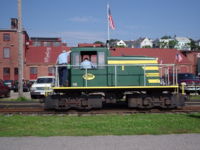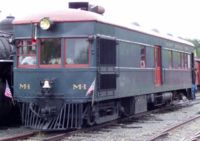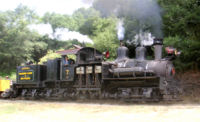American narrow gauge railroads
Eastern US

In 1866, the East Tennessee and Western North Carolina Railroad constructed a narrow gauge railroad between Johnson City, Tennessee and Cranberry, North Carolina. It continued in service until 1950. In 1957, the railroad was revived as a tourist attraction under the common name, Tweetsie Railroad. It currently runs a three mile route near Blowing Rock, North Carolina.
The last remaining 3 ft (914 mm) gauge line east of the Mississippi River is the East Broad Top Railroad in Central Pennsylvania. Running from the 1800s until 1956, it supplied coal to brick kilns and general freight to the towns it passed through, connecting to the Pennsylvania Railroad at Mount Union, Pennsylvania. Purchased for scrap by the Kovalchick Corporation when it was shut down, it sat for four years until it was partly resurrected by townspeople of Orbisonia in 1960. Still owned by the Kovalchick family, trains operate over 5 miles of the original 32-mile line.
There were extensive 2 ft (610 mm) gauge lines in the Maine forests early in the 20th century. Although essentially for the transport of timber and slate, the Maine lines did run some passenger services. Some cars and trains from these lines are now on display at the Maine Narrow Gauge Railroad Museum in Portland, Maine.
Western US
Colorado
In the United States a major 3 ft (914 mm) gauge railway system was built in the mountains of Colorado by the Denver and Rio Grande Railroad. It was hundreds of miles in length and effectively circled the state. Feeder lines were run to the mining communites of Leadville, Aspen, Cripple Creek, Telluride and Silverton. The northern trunk line was re-gauged to standard early, but the southern portions remained steam hauled and narrow gauge until the 1960s. Small remnants of that system remain as tourist attractions which run in the summer, including the Cumbres and Toltec Scenic Railroad which runs between Antonito, CO in the San Luis Valley and Chama, NM; and the Durango and Silverton Narrow Gauge Railroad which runs in the San Juan Mountains between its namesake towns of Durango and Silverton. A small operation-the Uintah Railway- operated in Utah and Colorado. Colorado is respected as the largest mother lode of narrow gauge railroading in North America. To this end, more museums and tourist trains have opened in the last few years.
California and Coast
The famous San Francisco cable car system has a gauge of 3 ft 6 in (1067 mm), as did the street cars on the former Los Angeles street railway. Many narrow gauge lines were private carriers serving particular industries. One major industry that made extensive use of 3 ft (914 mm) gauge railroads was the logging industry, especially in the West. Although most of these lines closed by the 1950s, one notable later survivor was West Side Lumber Company railway which continued using 3 ft (914 mm) gauge geared steam locomotives until 1968. Much of the equipment from the Westside found its ways to tourist lines, including the Roaring Camp and Big Trees Narrow Gauge Railroad and Yosemite Mountain Sugar Pine Railroad in California and the Midwest Central Railroad in Iowa. The Southern Pacific operated the Tonopah and Tidewater Railway between Nevada and Death Valley it became the Colorado and Carson Railway. Another major SP line was the Oregon, California and Nevada railroad, running from Reno into southern Oregon. Parts of these SP lines have been saved at the Grizzley Flats Railroad, and Laws Depot. There is one narrow gauge industrial railroad still in commercial operation in the United States, the US Gypsum operation in Plaster City, California which uses a number of Alco locomotives obtained from the White Pass after its 1982 closure.
Two small regional railways in the Pacific Northwest were the Ilwaco Railway and Navigation Co near Astoria, and the Sumpter Valley Railway near Baker. The latter one still operates in the summer.
Alaska
The last surviving commercial common carrier narrow-gauge railroad in the United States is the White Pass and Yukon Route connecting Skagway, Alaska and Whitehorse, Yukon Territory; this closed in 1982, but has since been partially reopened as a tourist railway.


